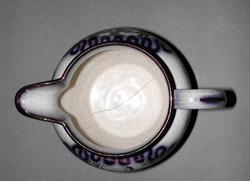Current Location: In storage
Titles
Princess Royal & Prince of Prussia jug
Maker(s)
Production:
Unidentified factory
(Probably)
Entities
Categories
Description
White earthenware, painted under-glaze in blue, glazed, transfer-printed in brown and painted with enamels and copper lustre.
Squat jug with bulbous body, cylindrical neck, flared foot and loop handle. Decorated on each side with a transfer which is hand painted in red, yellow and green enamels. Each transfer is framed by a waving line of lustre, set on a ground of underglaze blue. Thin bands of lustre around the rim and neck, a line down the handle and lustre decorations under the lip are similarly ‘shadowed’ by under-glaze blue. The underside is flat and glazed, with a raised foot-rim.
The images and text are as follows:
(a) the Princess Royal and Prince Frederick, the Princess wearing a crinoline. They are surrounded by painted flowers, with their name labels below: ‘PRINCESS ROYAL / PRINCE OF PRUSSIA’;
(b) a view of the Prince’s palace in Berlin, with a carriage and people promenading in the foreground, the ladies wearing crinolines, flanked by grass and trees painted in green enamel.
Notes
History note: Stanley Woolston, Cambridge, from whom purchased on 2 July, 1907, by Dr J.W.L. Glaisher, FRS, Trinity College, Cambridge .
Legal notes
Dr. J.W.L. Glaisher Bequest, 1928
Acquisition and important dates
Method of acquisition: Bequeathed
(1928-12-07)
by
Glaisher, J. W. L., Dr
Dating
Victoria I
19th Century, Mid
Circa
1857
-
1858
Note
Lustreware was popular in England throughout the first half of the 19th Century. Minute amounts of gold were used to produce copper, gold, pink or purple lustre, depending on the type of clay, lustre formula, number of layers and firing temperature; platinum was used to mimic silver. Transfer printing was introduced in the second half of the 18th century, often using the glue bat method. The design was engraved on a copper plate, which was covered with linseed oil; a thin bat of animal glue was pressed onto the oiled plate and then applied to the ware. The ware was then dusted with powdered metallic oxide, which adhered to the oil, and fired to fix the design. Round-bodied vessels were particularly well suited to this method as the flexible bat could be stretched around curves.
This type of jug was made for everyday use. The shape and size of this example suggest it may be for milk. The transfers indicate the date of manufacture. Victoria, Princess Royal (the eldest child of Queen Victoria) was betrothed to Prince Frederick William of Prussia in 1857 and they married on 25 January 1858. Frederick became Emperor of Germany and King of Prussia in March 1888, but died just 99 days later. Thereafter, Victoria was known as The Empress Frederick. The style of decoration and choice of transfers suggests the jug was made in Germany, perhaps for the English market.
School or Style
German
People, subjects and objects depicted
Components of the work
Decoration
composed of
enamels
( green, yellow, red)
lustre
( pink, copper)
underglaze cobalt-blue
clear glaze
Materials used in production
white
Earthenware
Techniques used in production
Throwing
: Earthenware, painted under-glaze in blue, glazed, transfer-printed in brown and painted with enamels and lustre.
Inscription or legends present
- Text: 136
- Location: Underside of base
- Method of creation: Hand-painted in pink lustre
- Type: Mark
- Text: ‘2649. Tranfer printed jug with the portraits of Princess Royal and Prince Frederick of Prussia (married Jan 25 1858) b. at Cambridge July 2nd 1907. foreign?'
- Location: Underside of base
- Method of creation: Rectangular paper label handwritten in black ink
- Type: Label
References and bibliographic entries
Identification numbers
Accession number: C.1167-1928
Primary reference Number: 71445
Stable URI
Audit data
Created: Saturday 6 August 2011
Updated: Tuesday 30 April 2024
Last processed: Tuesday 15 July 2025
Associated departments & institutions
Owner or interested party:
The Fitzwilliam Museum
Associated department:
Applied Arts






